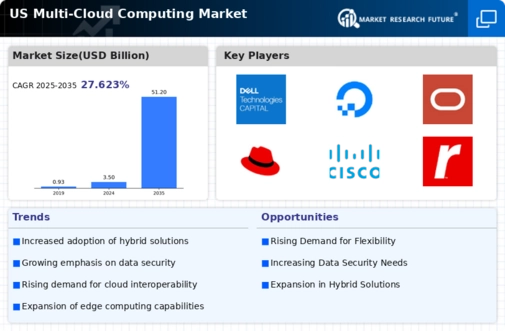Growing Demand for Scalability
The multi cloud-computing market is experiencing a notable surge in demand for scalability solutions. Organizations are increasingly seeking flexible cloud environments that can adapt to their evolving needs. This trend is driven by the necessity for businesses to manage fluctuating workloads efficiently. According to recent data, approximately 70% of enterprises in the US are prioritizing scalable cloud solutions to enhance operational efficiency. The ability to scale resources up or down as required allows companies to optimize costs and improve performance. As a result, the multi cloud-computing market is projected to witness significant growth, with projections indicating a compound annual growth rate (CAGR) of around 20% over the next five years.. This growing emphasis on scalability is reshaping the competitive landscape, compelling providers to innovate and offer more robust solutions.
Rising Adoption of Edge Computing
The multi cloud-computing market is increasingly influenced by the rising adoption of edge computing technologies. As organizations seek to process data closer to the source, the integration of edge computing with multi cloud strategies is becoming more prevalent. This trend is driven by the need for real-time data processing and reduced latency, particularly in industries such as manufacturing and healthcare. Recent estimates suggest that around 50% of US enterprises are exploring edge computing solutions in conjunction with their multi cloud environments. This convergence allows businesses to leverage the strengths of both edge and cloud computing, enhancing operational efficiency and enabling innovative applications. As the demand for edge computing continues to grow, the multi cloud-computing market is expected to evolve, presenting new opportunities for service providers and enterprises alike.
Enhanced Disaster Recovery Solutions
The multi cloud-computing market is witnessing a heightened emphasis on disaster recovery solutions. Organizations are increasingly recognizing the importance of robust backup and recovery strategies to safeguard their data. Recent statistics reveal that approximately 75% of US enterprises consider disaster recovery a top priority in their cloud strategy. Multi cloud environments offer enhanced resilience by distributing data across multiple platforms, thereby reducing the risk of data loss. This capability is particularly appealing to businesses that require high availability and minimal downtime. As the demand for reliable disaster recovery solutions continues to rise, the multi cloud-computing market is poised for growth, with projections suggesting an increase in investments in this area over the coming years.
Increased Focus on Cost Optimization
Cost optimization remains a critical driver in the multi cloud-computing market. Organizations are increasingly aware of the financial implications of cloud services and are actively seeking ways to reduce expenses. A recent survey indicates that nearly 60% of US companies are implementing multi cloud strategies to leverage competitive pricing among different providers. By distributing workloads across various cloud platforms, businesses can take advantage of cost-effective solutions while avoiding vendor lock-in. This strategic approach not only enhances financial flexibility but also fosters a more competitive environment among cloud service providers. As companies continue to prioritize cost efficiency, the multi cloud-computing market is expected to expand, with analysts forecasting a growth trajectory that aligns with the increasing demand for budget-friendly cloud solutions.
Regulatory Compliance and Data Sovereignty
Regulatory compliance is a significant driver in the multi cloud-computing market, particularly in the US. Organizations are increasingly required to adhere to stringent data protection regulations, such as the General Data Protection Regulation (GDPR) and the Health Insurance Portability and Accountability Act (HIPAA). This regulatory landscape compels businesses to adopt multi cloud strategies that ensure data sovereignty and compliance with local laws. Approximately 65% of US companies report that compliance concerns influence their cloud deployment decisions. By utilizing multiple cloud providers, organizations can better manage data residency requirements and mitigate risks associated with non-compliance. As regulatory pressures continue to evolve, the multi cloud-computing market is likely to expand, driven by the need for compliant and secure cloud solutions.

















Leave a Comment